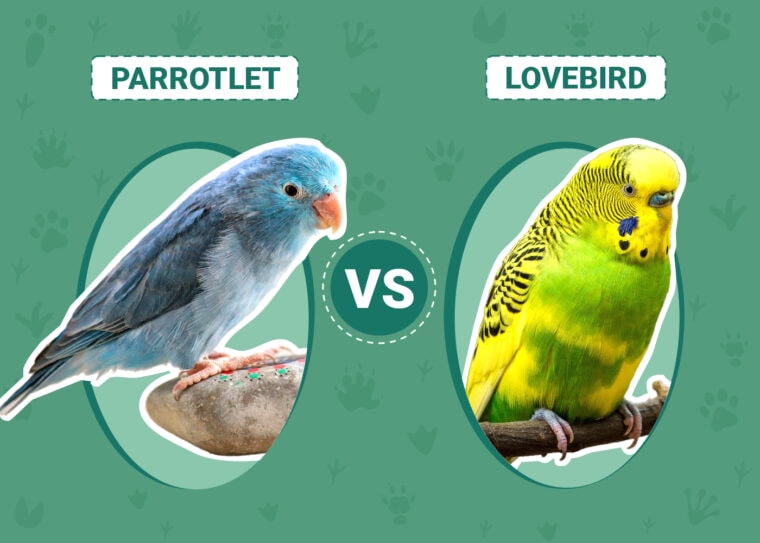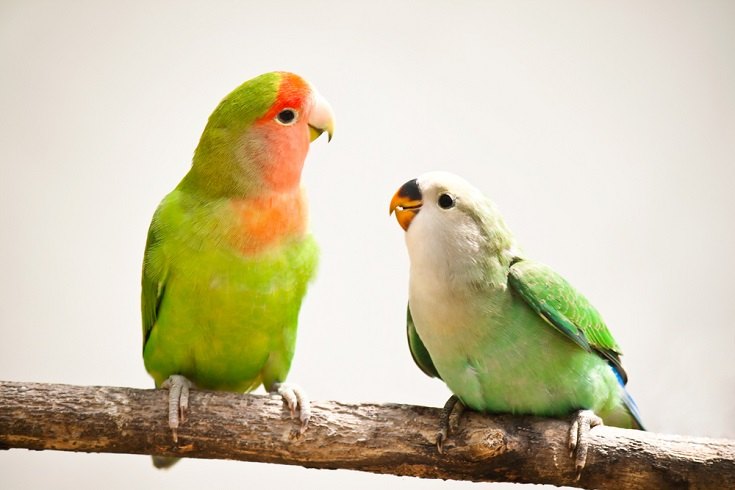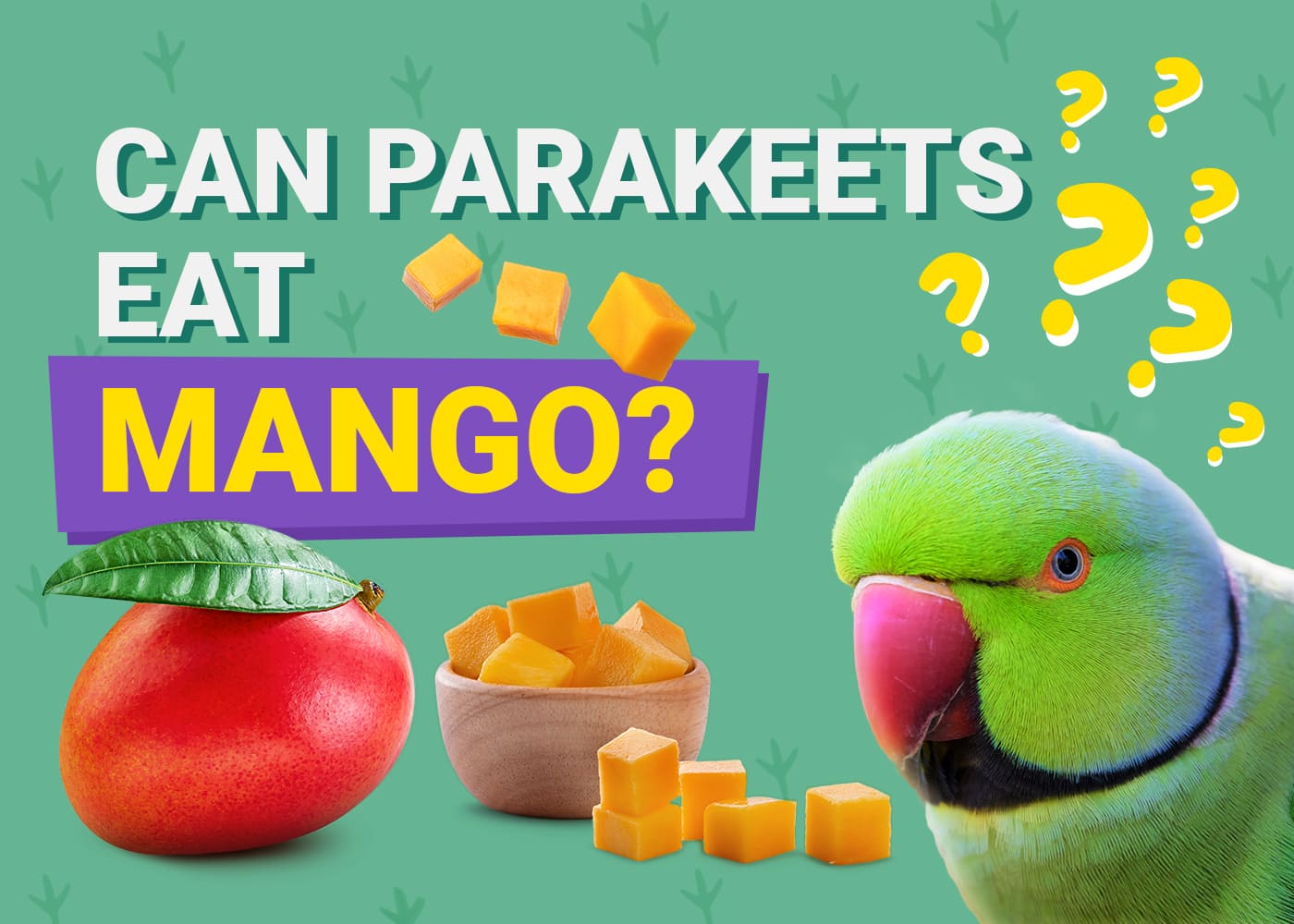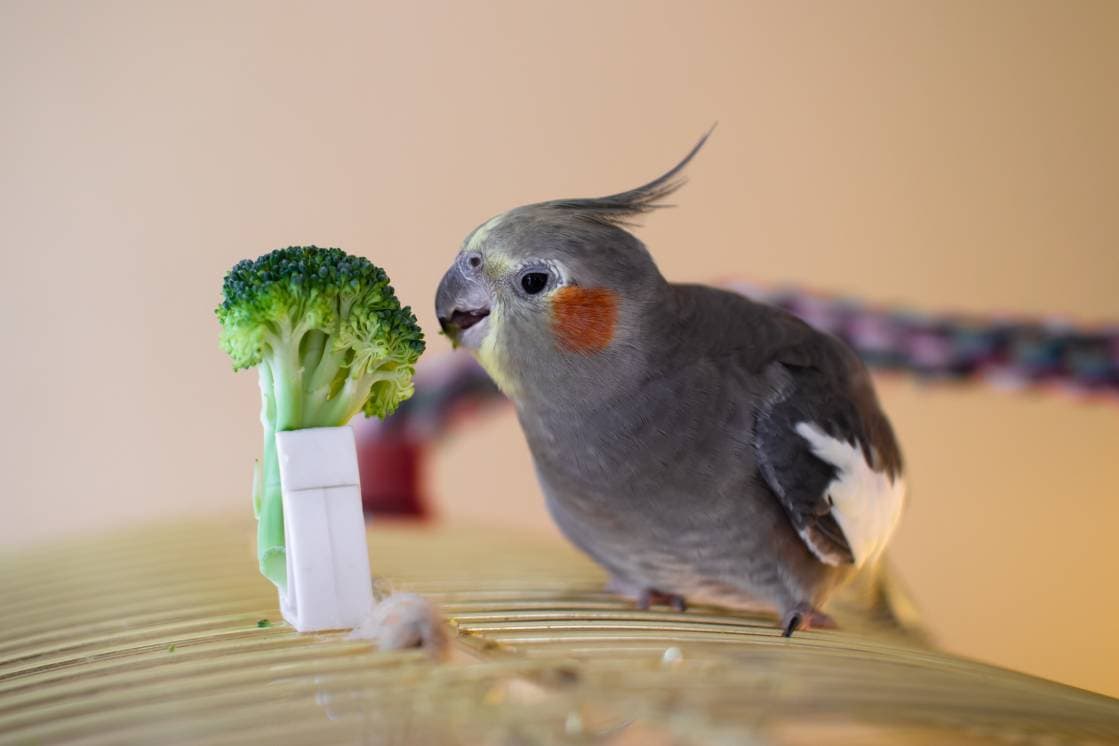
Click to Skip Ahead
At first glance, the Parrotlet and Lovebird look similar and even have similar behavioral characteristics. They are extremely friendly birds that love to be around humans and bond closely with their owners. Both birds make great companions due to their abundant personalities and entertaining characters. They are also extremely small birds within the parrot family, making them easy to care for and popular as pets.
However, to the experienced owner, these two birds are actually fairly different, and there are key differences to be aware of when choosing one or the other as a pet. In this article, we look at the differences between these two parrots and just what makes each of them so unique.
Visual Differences

The main difference between these two birds is size, and while both species are small, Lovebirds are slightly larger than Parrotlets by about 2 inches. Parrotlets are sexually dimorphic, meaning the males and females look noticeably different. Male Parrotlets usually have blue markings on their heads, tails, and wings, whereas females do not have these markings or they are barely visible at best. Male and female Lovebirds are almost impossible to tell apart without experience.
At a Glance
Parrotlet Overview

Parrotlets are native to Southern and Central America and are among the smallest parrots commonly kept as pets. There are many different species of Parrotlet, but the ones most commonly kept as pets are the Pacific or Celestial Parrotlet, the Mexican Parrotlet, the Spectacled Parrotlet, and the Yellow-Faced Parrotlet. In the wild, they are found in dry, wooded areas like banana plantations and typically forage on the ground for their food.
Personality
Parrotlets are generally quiet birds when kept as pets, though in the wild, they live in flocks and can be found constantly chattering. They can be taught a limited vocabulary but are not as vocal as larger birds like Macaws or African Greys. They are social, friendly, and affectionate birds that bond strongly with their owners and as such, make great pets and companions. Parrotlets are often described as “big birds in small bodies” and are known to be fairly fearless with other birds, animals, and humans!
Training & Exercise
Parrotlets are active birds that love to climb and play and need plenty of time outside their cage to exercise these natural instincts. They are generally easy to tame and train, though they need early socialization and regular handling or are otherwise prone to nipping at times. They can be trained to perform tricks and mimic words, though nowhere near the level of what some larger parrots are capable of.
It’s vital to begin training your bird as soon as you get them, and training sessions should be kept as short and entertaining as possible because Parrotlets have fairly short concentration spans.

Health & Care
The best food for Parrotlets is commercial pellets, with additional seed mixes and the occasional fruits and vegetables. While this should take care of all their nutritional needs, they’ll also benefit greatly from vitamin and calcium supplements. These are exceedingly healthy birds with few health issues if fed on a healthy, wholesome, and varied diet.
Parrotlets will need a cage of at least 24×24 inches, but bigger is better, and they should spend as much time outside their cage as possible. They love to bathe, so put them in a small bath occasionally to keep them cool, clean, and entertained. Parrotlets molt beginning at around 6 months old and are known to be rather temperamental and nippy during this time.
Suitability
While Parrotlets are a big responsibility and can live for up to 20 years, they are easier to look after than larger parrot species, which is part of their popularity. That said, they still need plenty of attention and interaction. Before buying any parrot species, make sure you have the time and resources to give these little creatures everything that they need to thrive.
Lovebird Overview

Lovebirds are among the most popular parrot species and are native to the continent of Africa. There are nine different species of Lovebirds that all belong to the genus Agapornis, which literally translates into “lovebird.” Only a few are commonly kept as pets, though, namely the Fischer’s Lovebird.
They got this name due to the strong pair bonds that they form with their partners, and as such, they should not be kept alone. In the wild, they are highly social and live in small flocks, which is another reason that these birds should be kept in pairs at least.
Personality
Lovebirds are highly active, playful, and curious and have a big personality jammed into a small package. In the wild and as pets, they are extremely social birds and great companion pets. That said, Lovebirds can be territorial at times, especially when not socialized and handled from a young age, and they are said to be prone to jealous behavior, especially the females.
Training & Exercise
Lovebirds are easy to train and tame, provided that they are socialized from a young age. Like Parrotlets, they are not known for their mimicking abilities but can learn a dozen or so words and sounds. They are definitely not as loud as larger parrot species, but they still produce high-pitched vocalization when they want your attention! These birds should spend as much time as possible outside their enclosure unless they are living in a large aviary, as this will give them adequate exercise and essential socialization. Their cage should be fitted with plenty of ropes, ladders, and perches, though, no matter how much time they spend outside.

Health & Care
Lovebirds in the wild are flock animals, and although many bird enthusiasts claim that Lovebirds do fine on their own, it is vital to their health and well-being that they have a partner. Even so, they should still be interacted with and handled regularly to provide them with social interaction. The larger the cage you can provide for them, the better, but a minimum of 2 feet wide by 4 feet long is an average estimate for a single bird.
As with all parrots, Lovebirds will thrive on a varied diet. Pelleted commercial bird food is a great staple, supplemented with a variety of fresh fruits and vegetables and seed mixes.
Suitability
Lovebirds are social animals that make ideal pets in a family home. These intelligent birds are easy to tame and train and are generally great with small kids who know how to handle them. While these birds are easier to care for than larger parrot species, they are still a massive responsibility.
Final Thoughts
At first glance, it’s easy to see why these two birds are often confused for each other. They are both small birds with similar features. However, Parrotlets are smaller, albeit not by much, and can be taught to mimic speech more easily than Lovebirds. Lovebirds are not sexually dimorphic, meaning the males and females look almost exactly alike, whereas male Parrotlets are more colorful than females and easy to spot.
Parrotlets and Lovebirds share many similarities, and either bird can make a great companion!
Featured Image Credit: Top – klickblick, Pixabay | Bottom – Anilsharma26, Pixabay









